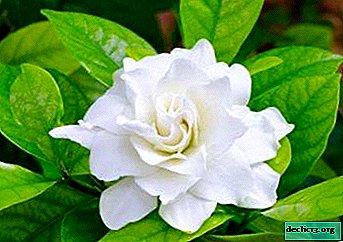Amazing pelargonium stellar, how to care for such an unusual plant?

Among the pelargonium there are many amazing varieties. One of the most unusual representatives of the family is stellate pelargonium or stellar. These plants boast a classic appearance and unusual shape of flowers.
In the article we will consider the features of growing stellar pelargonium at home, find out how to plant this unique plant, how to properly care for it, and you will also see how it looks.
Description
Stellars are unusual varieties of pelargonium. These are artificially bred varieties intended for decorative decoration of premises and landscape. Today stellars are becoming increasingly popular, since their refined and spectacular appearance is combined with their unpretentiousness and ease of care.
The peculiarity of the variety is the unusual shape of the petals: the edges are unevenly cut, resembling asterisks.Appearance Features
Many flower growers consider stellars to be the most beautiful representatives of the pelargonium family. Along with the unusual shape of the flowers, the plants also have very decorative leaves: also an unusual shape resembling maple. Note that the foliage of stellars can be of different colors: from standard green to chocolate, golden, red and even two-three-color.
We should also talk about the flowers of this plant. Their shape most closely resembles the small size of an asterisk. And given that many varieties of stellars are terry, the kind of plant as a whole is quite exotic.
Photos of these unusual plants
In the photo, amazing flowers loved by many gardeners:





Landing
We find out what requirements the stellars make to the conditions of their detention.
Location and Lighting
Stellate pelargonium needs enough light. Therefore, it is best to place a pot with a plant on well-lit window sills. In the summer, it is recommended to take the pot out into the air: balcony, veranda, terrace or garden.
Scorching sunlight is negatively perceived by the plant, as it can leave burns on delicate leaves and petals. Therefore, at noon in the summer, pelargonium requires shading.
In winter, it is recommended to organize additional illumination for the stellar, since in the conditions of a short daylight the plant will not be able to form a sufficient number of peduncles.
Temperature
The plant feels good at moderate temperatures.: in summer at + 20-25 degrees, and in winter at + 12-15 degrees. Excess heat is harmful to stellars - as well as too intense cooling.
In summer, it is better to take the plant out into the open air, but it is recommended to gradually accustom it to a cooler temperature and more light.Soil composition
 The soil requirements for stellate pelargonium are standard. It is important that the soil is non-acidic, loose and sufficiently nutritious.
The soil requirements for stellate pelargonium are standard. It is important that the soil is non-acidic, loose and sufficiently nutritious.
It is recommended to purchase finished land in a store - Pelargonium soil mixture is ideal.
If there is a desire and the opportunity to make the mixture on your own, then you should take in equal parts turf, leaf soil, as well as peat and sand - in this case, such a mixture would be the best option.
How to care?
Consider the main points for caring for stellar pelargonium.
Watering
These plants need to be hydrated only if the topsoil is dried. Overmoistening is harmful to stellars, as it can lead to decay of their root system.
In summer in warm weather, watering can be more plentiful, but in winter rare and scarce. Drying up of an earthy coma, however, must also be avoided, as this affects badly the well-being of star-like beauties: their leaves begin to turn yellow and fall off. You can also spray these plants if the air is dry and hot.
Top dressing
For plant growth and lush flowering need additional nutrition. Use ready-made mineral formulations designed for plants of this family. Stellars are fed in spring and summer, but in winter plants do not need to be fed.
Keep in mind that for lush and abundant flowering, pelargonium must be fed phosphorus in early summer and potassium, nitrogen in the summer should be excluded from the "diet". The fact is that nitrogen contributes to the magnificent growth of foliage and shoots (greenery), while inflorescences do not form.
The plant should not be overfed, as abundant nutrition leads to its insufficiently active flowering. And organic fertilizers in this case are generally better not to use, since they negatively affect the decorativeness of stellars.Transfer
 If stellate pelargonium has grown out of its old pot, it must be transplanted into a new "house". Transplant in the spring after the end of hibernation of the plant.
If stellate pelargonium has grown out of its old pot, it must be transplanted into a new "house". Transplant in the spring after the end of hibernation of the plant.
In order for pelargonium to bloom well and magnificently, it is recommended to choose a new pot with a diameter slightly larger than the previous one: literally, by one and a half to two centimeters. In a large capacity, there will be no magnificent flowering of stellars. You should know that after transplantation, pelargonium can not be fed for a month and a half, since there are still enough minerals in the new soil.
Pruning
In order for the stellars to form a lush, compact bush, strewn with many flowers, it is recommended to pinch their apical young shoots in time. Thus, more active formation of lateral branches will go, as well as an abundant formation of inflorescences.
In autumn, after flowering is completed, it is recommended to remove diseased, weak and dried shoots from plants. Thus, by spring, the flower will come to its senses after pruning, and will be able to form new, healthy shoots to replace the removed ones. In the spring, it is not recommended to prune the plant, since this can negatively affect flowering: you can simply cut off many of the peduncles that began to form.
Diseases
Pelargonium can be affected by pests and diseases, and have various problemsassociated with deficiencies in care and maintenance. Next, we consider the most common problems that arise when growing these beautiful plants.
Edema
Some gardeners notice the appearance of soft watery pads on the leaves of plants. These defects occur due to overmoistening of the soil, and in order to eliminate edema, it is urgently necessary to reduce watering.
Leaves fall, stems are exposed
Similar problems arise if stellars are not kept in a sufficiently bright place. To eliminate ugly "flaws in appearance", rearrange the pot with the plant on the most well-lit window sill in the house.
Gray rot
 This disease is the most commonly occurring in this type of pelargonium. Pathology is caused by a fungus, and occurs due to excessive waterlogging of the plant. Note that gray rot is contagious, therefore measures to save the plant must be taken radical and urgent.
This disease is the most commonly occurring in this type of pelargonium. Pathology is caused by a fungus, and occurs due to excessive waterlogging of the plant. Note that gray rot is contagious, therefore measures to save the plant must be taken radical and urgent.
It is necessary to remove and burn the leaves affected by the disease, the whole plant and standing next to it should be treated with a fungicide from the sprayer. In addition, a mandatory measure is to reduce watering and increase the frequency of airing.
Pests
Of the insects, the greatest danger is for stellars:
- weevil;
- whitefly;
- aphid.
To cope with pests, spray the plant with an appropriate insecticidal preparation.
Breeding
Stellate pelargonium is propagated by cuttings. The seed method is rarely used at home due to unwarranted inheritance by plants of parental species characteristics. Simply put, star-grown pelargonium grown from a seed most often turns out to be an ordinary plant without the characteristic features of stellars. Next, we consider in detail the algorithm for the propagation of stellate pelargonium by cuttings.
- Cuttings in this case are cut in spring or summer, using adult, well-developed uterine specimens for this. Keep in mind that the shoot cut off for propagation must be semi-lignified, since green young shoots usually rot before they take root.
- It is important that the cutting has from three to five internodes and at least four leaves. The bottom sheets must be removed, as this part of the handle will be underground.
- After cutting, the cuttings are dried in the open air (in paper) for a couple of hours, after which they are rooted in the ground or in water. The latter option seems simpler, however, in this case, the cuttings often rot to root.
 It is important to ensure that the cuttings have a warm temperature and enough light: in this case, usually the majority of cut shoots take root. After 2-3 weeks, the shoot gives roots, after which it can be transplanted into a separate pot.
It is important to ensure that the cuttings have a warm temperature and enough light: in this case, usually the majority of cut shoots take root. After 2-3 weeks, the shoot gives roots, after which it can be transplanted into a separate pot.- Keep in mind that the diameter of the pot for a young plant should not be too large - 7-9 cm is enough. Otherwise, pelargonium will not be able to bloom early.
Note that one copy of pelargonium preserves its decorative and healthy appearance from two to five yearsTherefore, it will be necessary to renew the plant population regularly. To get a full-grown adult from an active stem, an actively flowering plant takes about one year. And although the cuttings, rooted in the spring, usually bloom in the same summer, they will be able to show their full potential only next year.
Conclusion
We learned what stellar pelargonium is and figured out how to care for this wonderful plant. As you can see, stellate varieties of pelargonium are not picky and capricious, so grow this flower is a strength and a beginner. Using the advice from the article, you can effortlessly grow a lushly flowering ornamental plant.

 It is important to ensure that the cuttings have a warm temperature and enough light: in this case, usually the majority of cut shoots take root. After 2-3 weeks, the shoot gives roots, after which it can be transplanted into a separate pot.
It is important to ensure that the cuttings have a warm temperature and enough light: in this case, usually the majority of cut shoots take root. After 2-3 weeks, the shoot gives roots, after which it can be transplanted into a separate pot.















